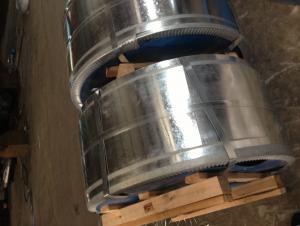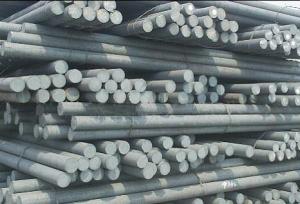Hot Dip Galvanized Steel Round Bars
- Loading Port:
- Tianjin
- Payment Terms:
- TT OR LC
- Min Order Qty:
- 100 m.t.
- Supply Capability:
- 500000 m.t./month
OKorder Service Pledge
OKorder Financial Service
You Might Also Like
Specification
Hot Dip Galvanized Steel Round Bars
Product Description of Hot Dip Galvanized Steel Round Bars
1. Steel grade: ASTM4140, SCM440, 42CrMo, DIN1.7225
2. Length: 6M-12M
3. Diameter: 16mm-300mm
4. Product range: round bar, flat bar, square bar
5. Technique: Hot rolled, forged, cold drawn
Specification of Hot Dip Galvanized Steel Round Bars
Material | SCM4140 | Round bar | Dia(mm) | 16-300mm |
Process | EAF + LF + VD + Forged + Heat Treatment (optional) | Length (mm) | Max 12m | |
Heat treatment | Normalized / Annealed / Quenched / tempered | Flat bar | Thickness(mm) | 8-500mm |
Delivery condition | Hot forged +Rough machined (black surface after Q/T)+ Turned (optional) | Width(mm) | 70-200mm | |
Test | Ultrasonic test according to SEP 1921-84 D/d | Length (mm) | Max 12m |
Chemical Composition of Hot Dip Galvanized Steel Round Bars
C | Si | Mn | Cr | Mo | P | S |
0.38~0.43 | 0.15~0.35 | 0.75~1.00 | 0.8~1.1 | 0.15~0.25 | ≤0.035 | <0.04< td=""> |
Photo Show of Hot Dip Galvanized Steel Round Bars

Packing and Delivery:
Packing in bundle package, or as customer's requirements.
Delivery Detail: 45 days after receiving the deposit.
Usage and Applications of Hot Dip Galvanized Steel Round Bars
1. Steel round bar is used in a large number of architectural and engineering structures. Or it can be used in construction of plants for the production of steel house frames, high-voltage transmission towers, bridges, vehicles, boilers, containers, ships, etc.
2. And we can use this kind of product on the performance of the mechanical parts if the demand is not very high.
3. Some special material steel round bar can be used for main shaft of steamer, hummer shank, with big section and supper force.
Company Information
CNBM International Corporation is the most important trading platform of CNBM group.
Whith its advantages, CNBM International are mainly concentrate on Cement, Glass, Iron and Steel, Ceramics industries and devotes herself for supplying high qulity series of refractories as well as technical consultancies and logistics solutions.


F A Q
1, Your advantages?
professional products inquiry, products knowledge train (for agents), smooth goods delivery, excellent customer solution proposale
2, Test & Certificate?
SGS test is available, customer inspection before shipping is welcome, third party inspection is no problem
3, Factory or Trading Company?
CNBM is a trading company but we have so many protocol factories and CNBM works as a trading department of these factories. Also CNBM is the holding company of many factories.
4, Payment Terms?
30% TT as deposit and 70% before delivery.
Irrevocable L/C at sight.
5, Trading Terms?
EXW, FOB, CIF, FFR, CNF
6, After-sale Service?
CNBM provides the services and support you need for every step of our cooperation. We're the business partner you can trust.
For any problem, please kindly contact us at any your convenient time.
We'll reply you in our first priority within 24 hours.
- Q: Can steel round bars be used in the manufacturing of electrical components?
- Indeed, the utilization of steel round bars is feasible in the production of electrical components. The malleable nature of steel renders it a flexible material that endows exceptional vigor and robustness, thus rendering it apt for a plethora of applications, including the manufacturing of electrical components. Steel round bars can be employed as linkages, connectors, or supports in electrical devices and apparatus. Consequently, they impart stability, reinforcement, and shielding to the electrical components, guaranteeing their optimal operation and protracted lifespan. Furthermore, steel is easily machinable, weldable, and moldable, thereby enabling manufacturers to tailor the round bars to the specific requirements of the electrical components. Nevertheless, one must bear in mind that depending on the precise application and environment in which they are employed, steel round bars may necessitate appropriate insulation or coating to prevent any electrical conductivity or interference.
- Q: Can steel round bars be used in the telecommunications industry?
- Yes, steel round bars can be used in the telecommunications industry. Steel round bars are commonly used to provide structural support for various telecommunications equipment such as antennas, satellite dishes, and communication towers. These bars are highly durable and can withstand harsh weather conditions, making them suitable for outdoor installations. Additionally, steel round bars can be easily fabricated and shaped to meet specific design requirements, allowing for the integration of various components in the telecommunications infrastructure.
- Q: Are steel round bars available in different lengths?
- Yes, steel round bars are available in different lengths.
- Q: Requirements for groove welding of grade 22mm round steel and manual arc welding
- If not on the lathe, in the groove on the round bar with gouging or cutting gun, docking form X type double sided bilateral docking, blunt edge 2mm root gap 2mm welding, welding side sincere one or two seam, flip the workpiece on the other side of a full weld groove, flip weld residual,
- Q: Can steel round bars be used in the construction equipment industry?
- In the construction equipment industry, it is common to use steel round bars. These bars are well-known for their strength, durability, and versatility, which makes them suitable for various applications in construction equipment. They can be utilized to produce components like axles, shafts, pins, and fasteners. The robustness of steel round bars guarantees that construction equipment can withstand heavy loads and harsh working conditions. Moreover, steel round bars are easily machinable and weldable, enabling manufacturers to create intricate and customized designs for construction equipment. All in all, due to their exceptional mechanical properties and ability to enhance equipment performance and longevity, steel round bars are extensively employed in the construction equipment industry.
- Q: What is a steel round bar?
- A steel round bar, a lengthy metal rod with a circular shape, is usually made of strong and durable steel, an alloy composed mainly of iron and carbon. The round bar finds wide usage in industries like construction, manufacturing, and engineering, thanks to its flexibility and dependability. It is frequently employed as a structural element in buildings, as reinforcement or support in concrete structures, or as a part in machinery and equipment. The round shape enables effortless handling, machining, and welding procedures. Steel round bars are available in different diameters and lengths, and they can be further tailored or manufactured to suit particular project needs.
- Q: What is the difference between a hot rolled and a precision ground steel round bar?
- The manufacturing processes and resulting surface finishes of a hot rolled steel round bar and a precision ground steel round bar are the primary factors that differentiate them. Hot rolled steel round bars are created by heating the steel billet or ingot to high temperatures and passing it through a series of rollers to achieve the desired shape and size. This method yields a rougher surface finish with visible mill-scale or oxide layers. Additionally, the hot rolling process allows for variations in size and shape, making it a cost-effective choice for producing steel round bars in large quantities. On the other hand, precision ground steel round bars undergo a more refined and controlled manufacturing process. After the initial hot rolling, the bar is ground to achieve a smooth and consistent surface finish. Precision grinding eliminates the mill-scale and oxide layers, resulting in a more polished appearance. This process also ensures tight dimensional tolerance and improved straightness of the round bar. The selection between a hot rolled and a precision ground steel round bar depends on the specific application requirements. Hot rolled round bars are commonly used in applications where surface finish is not crucial, such as structural components, machinery parts, or construction materials. In contrast, precision ground steel round bars are employed in applications that demand a smooth surface finish, precise dimensions, and tight tolerances, such as in the production of precision tools, machinery components, or in industries like aerospace or automotive. In conclusion, the key distinction between a hot rolled and a precision ground steel round bar lies in their manufacturing processes and resulting surface finishes. Hot rolled round bars offer cost-effectiveness and versatility, while precision ground round bars provide a smoother surface finish, tighter tolerances, and improved dimensional accuracy for more demanding applications.
- Q: What are the different types of steel round bars used in the automotive drivetrain systems?
- There are several types of steel round bars commonly used in automotive drivetrain systems, including alloy steel, carbon steel, and stainless steel. These bars are chosen based on their specific properties and characteristics, such as strength, durability, and resistance to corrosion. The selection of the type of steel round bar depends on the specific application and requirements of the drivetrain system.
- Q: Can steel round bars be used for making oil and gas industry components?
- Yes, steel round bars can be used for making oil and gas industry components. Steel round bars are commonly used in the oil and gas industry due to their high strength, durability, and resistance to corrosion. These components require materials that can withstand harsh environments, high pressures, and extreme temperatures, and steel round bars meet these criteria. They are commonly used to manufacture various components such as valves, flanges, pipes, and fittings, which are vital for the functioning of the oil and gas industry. Additionally, steel round bars can be easily machined and welded, allowing for the fabrication of complex shapes and structures required in this industry. Overall, steel round bars are a reliable and widely used material for making oil and gas industry components.
- Q: What is the difference between carbon steel and stainless steel round bars?
- The composition and properties of carbon steel and stainless steel round bars differ significantly. Carbon steel round bars are composed primarily of iron and carbon, with trace amounts of other elements. They are renowned for their strength and durability, making them ideal for use in industries like construction and automotive. In terms of affordability, carbon steel round bars are generally more cost-effective than stainless steel round bars. In contrast, stainless steel round bars are a type of steel alloy that contains a minimum of 10.5% chromium. This addition of chromium gives stainless steel its distinct properties, including resistance to corrosion. As a result, stainless steel round bars are highly resistant to rust and staining, making them suitable for use in environments exposed to moisture and chemicals. Industries such as food processing, medical equipment, and marine applications commonly utilize stainless steel round bars. The chromium content in stainless steel round bars generally leads to higher prices compared to carbon steel round bars. However, the added cost is justified by the superior corrosion resistance and aesthetic appeal of stainless steel. Furthermore, stainless steel offers a range of grades and finishes, allowing for customization based on specific requirements. In conclusion, the primary distinction between carbon steel and stainless steel round bars lies in their composition and properties. Carbon steel is known for its strength and affordability, while stainless steel provides corrosion resistance and various customization options. The choice between the two depends on the specific application and the desired properties required for the project.
Send your message to us
Hot Dip Galvanized Steel Round Bars
- Loading Port:
- Tianjin
- Payment Terms:
- TT OR LC
- Min Order Qty:
- 100 m.t.
- Supply Capability:
- 500000 m.t./month
OKorder Service Pledge
OKorder Financial Service
Similar products
Hot products
Hot Searches
Related keywords


































